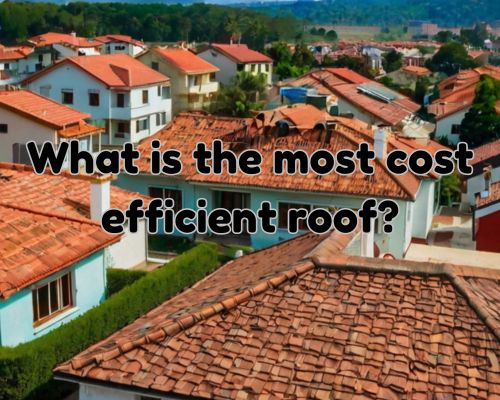“When building or renovating a home, the roof is one of the most important elements to consider. Not only does it protect you and your belongings from the elements, but it also plays a significant role in the overall energy efficiency of your home.” said David Spade of Star Roofing.

But with so many roofing options available, it can be challenging to determine which one is the most cost-efficient for your needs.
The most cost-efficient roof for your home depends on a variety of factors, including your budget, climate, and personal preferences.
Some of the most popular roofing options include asphalt shingles, metal roofing, and cool roofs.
Asphalt shingles are the most common roofing material used in the United States due to their affordability, durability, and ease of installation.
Metal roofing, on the other hand, is a more expensive option but can last up to 50 years and is highly durable.
Cool roofs are designed to reflect sunlight and reduce heat absorption, making them an excellent choice for warmer climates.
Evaluating Roofing Materials
When evaluating roofing materials, there are several factors to consider.
These include the pros and cons of different materials, their longevity, and maintenance requirements, as well as their energy efficiency and insulation properties.
Material Pros and Cons
Different roofing materials have their own unique advantages and disadvantages.
For example, asphalt shingles are generally the most affordable option but may not last as long as other materials.
Metal roofing, on the other hand, is durable and long-lasting but can be more expensive upfront.
Clay and concrete tiles are also popular choices for roofing materials. They are both durable and fire-resistant, but can be heavy and require additional structural support.
Shingles are another option, with composite shingles being a more affordable choice than wood or slate shingles.
Solar panels and green roofs are newer options that are becoming increasingly popular.
Solar panels can help to reduce energy costs and may even generate excess energy that can be sold back to the grid.
Green roofs, which are covered in vegetation, can provide insulation and help to reduce urban heat island effects.
Longevity and Maintenance
The longevity and maintenance requirements of roofing materials also play a crucial role in their cost efficiency.
For example, while asphalt shingles are affordable, they may need to be replaced more frequently than other materials.
Metal roofing, on the other hand, can last for up to 50 years with proper maintenance.
Slate and tile roofs are also known for their longevity, with some lasting for over 100 years. However, they can be expensive upfront and may require specialized maintenance.
Wood shakes and shingles can also last for several decades but may be more susceptible to damage from moisture and pests.
Energy Efficiency and Insulation
Finally, the energy efficiency and insulation properties of roofing materials can impact their cost efficiency over time.
Cool roofs, which are designed to reflect sunlight and reduce heat absorption, can help to lower energy costs during the summer months.
Solar shingles and panels can also help to generate energy and reduce energy costs over time.
Cost Analysis and Savings
Initial Costs vs. Long-Term Savings
When choosing a cost-efficient roof, you should consider not only the initial cost but also the long-term savings.
While some roofing materials may have a higher upfront cost, they may save you money in the long run by reducing energy consumption and lowering your energy bills.
For example, energy-efficient roofs such as cool roofs or solar shingles may have a higher initial cost compared to traditional roofing materials. However, they can help reduce energy consumption and lower your energy bills, resulting in significant long-term savings.
Incentives and Rebates
In addition to long-term savings, there are also incentives and rebates available for homeowners who choose energy-efficient roofing materials.
Many states and local utility companies offer tax credits and rebates for installing energy-efficient roofs, which can help offset the initial cost.
If you are looking for a contractor that offers good roofing services, go to Star Roofing.
Impact on Property Value
Choosing a cost-efficient roof can also have an impact on your property value.
A high-quality roof can enhance the overall appearance of your home and make it more attractive to potential buyers.
Additionally, energy-efficient roofs can increase your home’s energy star rating, which can also increase its resale value.
Maintenance and Durability
It’s also important to consider the maintenance and durability of your roofing material.
While some materials may have a lower initial cost, they may require more maintenance and have a shorter lifespan, resulting in higher long-term costs.
On the other hand, more durable materials such as metal or tile may have a higher initial cost but require less maintenance and have a longer lifespan, resulting in lower long-term costs.
Insulation and Ventilation
Proper insulation and ventilation are also important factors to consider when choosing a cost-efficient roof.
A well-insulated and ventilated roof can help reduce energy consumption and lower your energy bills by improving the efficiency of your HVAC system.
Environmental Impact
Finally, it’s important to consider the environmental impact of your roofing material.
Choosing a sustainable and energy-efficient roofing material can help reduce your carbon footprint and contribute to a more sustainable future.
Overall, when choosing a cost-efficient roof, it’s important to consider a variety of factors such as initial cost, long-term savings, incentives and rebates, impact on property value, maintenance and durability, insulation and ventilation, and environmental impact.
By carefully considering these factors, you can choose a roofing material that meets your needs and helps you save money in the long run.